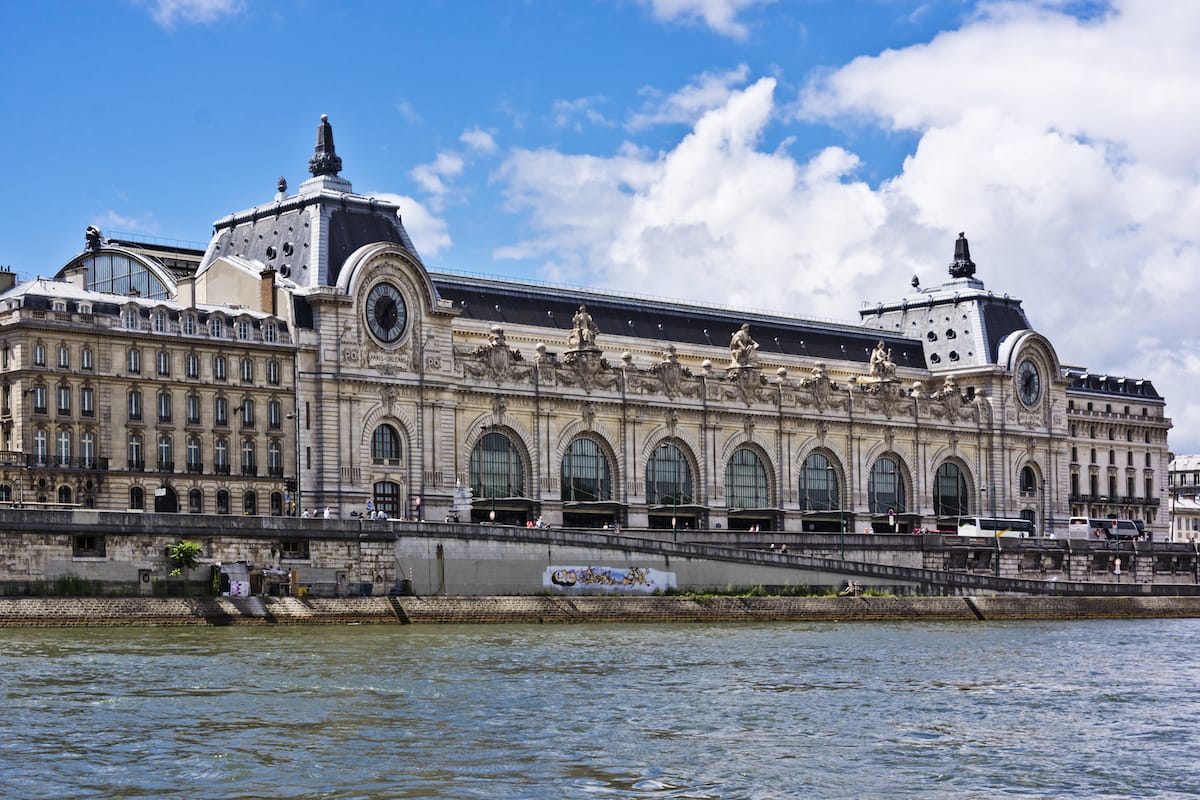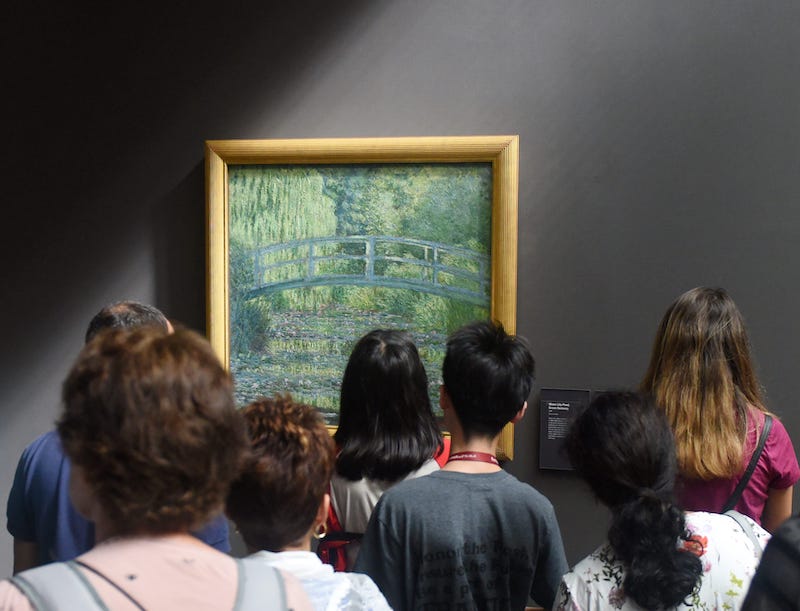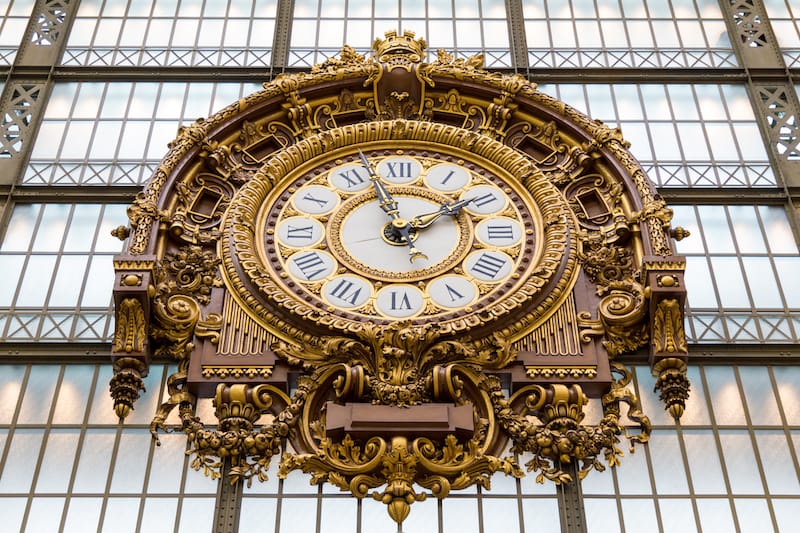Right on the banks of the Seine River in the heart of Paris, the Musée d’Orsay is one of France’s most visited museums. This guide will tell you what to know before you visit the Musée d’Orsay. Keep reading for more!
Be sure to book your accommodation and tours in Paris ahead of time to ensure availability! Here are our top picks!
🇫🇷 Popular tickets and tours in Paris:
- Musée d’Orsay guided tour w/ options (most popular ticket!)
- Paris Museum Pass (must-have for museum-goers)
- 1-Hour Seine River boat cruise (#1 Paris experience!)
- Louvre skip-the-line guided masterpieces tour
🛌 Top hotel recommendations in Paris:
- La Maison Favart (Luxury option near the Opera)
- Tilsitt Etoile (Mid-range in the 17th arr.)
- Ibis Hotel in Clichy (Budget – I stayed here and recommend)
🚗 Looking for the best way to get around Paris? Click here to check rental car rates for France!
Housed within a magnificent Beaux-Arts railway station, the Musée d’Orsay is a treasure trove of Impressionist and Post-Impressionist masterpieces, and it offers an unparalleled journey through the evolution of art in the 19th and early 20th centuries.
If you’re considering discovering some of the best museums in Paris, then the Musée d’Orsay should definitely be part of your trip!
In this article, we will give you all the necessary details to know before visiting the Musée d’Orsay, including essential information such as where the museum is located, how to get there, visitor information, and what to see inside!
In this post...
- Where is the Musée d’Orsay?
- How to Get to Musée d’Orsay
- Practical Information for Visiting the Musée d’Orsay
- Additional Helpful Tips for Visiting the Musée d’Orsay
- What to See in the Musée d’Orsay (Art Collection)
- Best Guided Tours of Musée d’Orsay
- About the Building
- Best Areas to Stay (Near Musée d’Orsay)
- More Paris Travel Guides
- Pin this Musée d’Orsay Guide
Where is the Musée d’Orsay?
Also known as the Orsay Museum, the Musée d’Orsay is in the 7th arrondissement of Paris, France.

The museum is on the left bank of the River Seine, near the city center, and is housed in a stunning Beaux-Arts railway station building.
It’s located at Esplanade Valéry Giscard d’Estaing, on Rue de la Légion d’Honneur, easily accessible via metro or public bus.
How to Get to Musée d’Orsay
There are different ways to get to the Musée d’Orsay in Paris by public transport; it all depends on where in Paris you may be staying. Keep in mind that the museum is on the left bank of the Seine, in the 7th arrondissement.
Getting to the Musée d’Orsay by Metro
The closest metro station to the Musée d’Orsay is the Solferino Station (line 12), located only a few steps from the museum.
Alternatively, you can use the RER (Regional Express Network) C line. The station closest to the museum is the Musée d’Orsay and it is a short walk from there.
Getting to the Musée d’Orsay by Bus
Different bus lines will take you to the Musée d’Orsay area. Lines 24, 63, 68, 69, 73, 83, 84, and 94 all have stops nearby.
If you prefer a scenic ride, you can purchase a hop-on, hop-off bus ticket and use it as your primary transport method in Paris.

This will also allow you to visit different areas in Paris for just one fee.
For instance, the Tootbus hop-on hop-off discovery bus tour offers 1, 2, or 3-day tickets with an informative audio guide.
Other Ways to Get to the Musée d’Orsay
Walking to the museum is also possible if you’re already in central Paris. Getting to the Musée d’Orsay can be a pleasant stroll along the Seine River from many central locations.
You will also find that many people use bikes. Paris has a bike-sharing program called Velib’, and you can rent a bike and cycle to the museum. There are also bike lanes along the Seine.
Other ways to reach the museum include taxis and ride-sharing, but you could also choose a unique approach and consider taking a Seine River cruise that stops at or near the Musée d’Orsay.
For instance, Paris’ Batobus hop-on hop-off sightseeing cruise is a river bus shuttle that provides a scenic and leisurely way to arrive at the museum.
Practical Information for Visiting the Musée d’Orsay
The Musée d’Orsay’s collection, set against a stunning architectural marvel backdrop, is a testament to human creativity and the enduring power of artistic expression, and, of course, a visit to the museum is one of the many unmissable things to do in Paris.

These are some of the essential details you need to know to get ready for a visit:
Musée d’Orsay Opening Hours
The museum is open from 9:30 am to 6 pm. On Thursdays, it has extended hours until 9:45 pm, and the closing day is Monday.
The best time for a visit to avoid the crowds is in the mornings, between 9:30 and 11 am. Visits in the late afternoon on Thursdays are less crowded, too.
Musée d’Orsay Tickets
You can purchase Musée d’Orsay tickets at the museum’s ticket counters; however, since this is one of Paris’ most famous museums, buying the tickets in advance and online will guarantee entrance at the time slot you prefer without waiting in long lines.
The museum offers various ticket options, including reduced student rates and free admission for visitors under 18.
Tickets purchased online (which guarantees entrance) costs €16. Tickets purchased on-site cost €14.
It also participates in the Paris Museum Pass, which can be a cost-effective way to visit multiple museums in Paris!
- Musée d’Orsay guided tour with options (the most popular ticket!)
- Skip-the-line Musée d’Orsay ticket and guided tour
You will also find that different combined tickets allow you to enjoy not only entrance to the Orsay Museum but also other popular activities, such as this very convenient (and super affordable) Musée d’Orsay entry ticket and Seine River cruise.
Additional Helpful Tips for Visiting the Musée d’Orsay
Accessibility: The Musée d’Orsay is wheelchair accessible and provides facilities and services for visitors with reduced mobility, including elevators and accessible restrooms.
Cafes and Restaurants at the Musée d’Orsay: There are a couple of on-site cafes and restaurants in the museum where you can take a break, enjoy a meal, or have a coffee.
BUY IT HERE: Paris Museum Pass
Security: Museums in Paris, including the Musée d’Orsay, typically have airport-like security checks at the entrance.
Coat Check: The museum has a cloakroom service to leave your coats and bags for a small fee. Large bags and backpacks may need to be checked as they might not be allowed inside the premises.
Audio Guides: The museum offers audio guides to rent in several languages. Guided tours in several languages are also available.

Gift Shop: The museum gift shop can be expensive but sells unique pieces and some truly fantastic art books. They also sell prints and other trinkets related to the museum’s collection.
Temporary Exhibitions: Besides its permanent collection, the museum often hosts temporary exhibitions featuring various artists and artistic movements. Sometimes, a different admission fee is requested for these exhibitions.
What to See in the Musée d’Orsay (Art Collection)
Focusing primarily on art from the nineteenth and early twentieth centuries, the museum hosts an exceptional collection of Impressionist and Post-Impressionist works by artists such as Monet, Manet, Degas, Renoir, Van Gogh, and Cézanne.
The museum is divided into various galleries and exhibition spaces on multiple floors. It also houses an extensive collection of sculptures, decorative arts, and photography.
Here are some of the pieces you should not miss:
1. Starry Night Over the Rhône by Vincent van Gogh: This beautiful painting captures the night sky over the Rhône River in Arles, and it’s one of Van Gogh’s iconic works.

2. Self-Portrait by Vincent van Gogh: Van Gogh’s self-portrait is a striking representation of the artist and his intense use of color.
This particular Portrait de l’artiste is one of several self-portraits made by the painter scattered in different museums worldwide.
3. Luncheon on the Grass by Édouard Manet: This provocative painting, often considered a precursor to Impressionism, depicts a picnic scene with a nude woman and fully dressed men.
The painting caused a massive scandal when it was first exhibited.
4. Bal du Moulin de la Galette by Pierre-Auguste Renoir: Renoir’s masterpiece shows a lively, sunlit scene of people dancing at an open-air dance hall in Montmartre.
5. Olympia by Édouard Manet: Another controversial work that depicts a reclining nude woman and was met with strong criticism when first displayed.

6. Water Lilies by Claude Monet: The museum houses several of Monet’s paintings belonging to the Water Lilies series, one of the most celebrated examples of Impressionism.
7. The Artist’s Studio by Gustave Courbet: This large-scale painting is a statement on art and society, with the artist at the center of a diverse group of characters and symbols.
8. Whistler’s Mother by James McNeill Whistler: This iconic portrait is one of the most famous American paintings.
Best Guided Tours of Musée d’Orsay
If you’re an art enthusiast, then a simple visit to the museum might leave you needing more information about the works exhibited.
Therefore, I encourage you to book a guided tour with an art specialist to make the most of the visit!
Here are a few picks of tours you can take (some are similar to one another, but they give you additional options if one has no availability during the time of your trip).
1. Musée d’Orsay Semi-Private Guided Tour: This tour is ideal if you have limited time, as it only focuses on the museum’s highlights. This is a 2-hour guided tour of the museum’s masterpieces by Van Gogh, Cezanne, Degas, Monet, and Manet.
2. Musée d’Orsay Guided Tour with Options: Visit the museum with an expert, English-speaking guide and choose among different visit options, such as private, semi-private, or group visits, and an after-visit lunch.

3. Musée d’Orsay Guided Tour with Ticket: This tour offers an expert introduction to the Musée d’Orsay to discover its most impressive masterpieces and learn all about them.
4. Musée d’Orsay Skip-The-Line Guided Tour: This is a 2-hour tour with an expert guide through many of the museum’s highlights, and it also includes a skip-the-line entry ticket.
About the Building
Although the impressive collection hosted in the museum is the highlight of any visit, don’t overlook the magnificence of the premises where it is hosted.
The Musée d’Orsay is housed in a magnificent Beaux-Arts railway station building, integral to its charm and historical significance.
The former Gare d’Orsay, a railway station inaugurated in 1900, was initially built for the Universal Exhibition of that year and served as a station for the trains coming from southwestern France.

Considered a prime example of Beaux-Arts architecture, the building’s highlights include ornate detailing and classical design elements.
One of the most distinctive features of the building is its large clock facade, with a giant clock facing the Seine River. This iconic clock can be seen from across the river and is a well-known museum symbol.
The railway station eventually closed in 1939 and was later used for various purposes, including as a mailing center.
In the 1970s, extensive renovations were undertaken to transform the station into a museum while preserving its historical and architectural significance. The Musée d’Orsay officially opened as a museum in 1986.

The building also features soaring ceilings and a grand central nave, where many of the museum’s masterpieces are displayed. One unique feature is the glass-roofed, upper-level mezzanine.
The Musée d’Orsay’s building is a work of art in itself and adds to the overall experience of visiting the museum.
It seamlessly blends historical architecture with modern museum facilities, making it a must-visit destination for architecture enthusiasts when visiting Paris!
Best Areas to Stay (Near Musée d’Orsay)
Since the museum is in the 7th arrondissement, it enjoys a very central location, close to many other attractions in the city.
Therefore, staying close to the Musée d’Orsay will allow you to be just a few steps from other exciting landmarks and attractions.
It’s a good idea to book accommodation on the Left Bank (Rive Gauche), an area that will grant easy access to the museum. Also, Saint-Germain-des-Prés is a gorgeous historic neighborhood just a short walk from the Musée d’Orsay.

The site is famous for its artistic and intellectual heritage and hosts many boutique hotels, cafes, and bookshops.
Also relatively close to the museum is the Latin Quarter (5th and 6th arrondissements). This area is excellent for budget travelers as it features a mix of budget and mid-range accommodations.
No matter where you stay in Paris, book well in advance, especially if you plan to visit during peak tourist seasons, including the summer and Christmas holidays.
Recommended Paris Hotels Near Musée d’Orsay
These are some of the places we suggest checking out when it’s time to book accommodation in Paris:
Hotel De Suede Saint Germain
This charming hotel is close to the Rodin Museum, the Musée d’Orsay, and Saint-Germain-des-Prés. It offers a daily breakfast served in a gorgeous interior garden.
The location is ideal, close to metro stops serving lines 10, 12, and 13.
Hôtel Londres Saint Honoré
A fantastic pet-friendly hotel in one of the best areas in Paris, the 1st arrondissement, the hotel is just 400 meters from the Louvre Museum and the Tuileries Gardens, a 5-minute walk from Place Vendome, and a 15-minute walk across the River Seine from the Musée d’Orsay.
Several metro lines connect the hotel with other areas in town.
Hôtel de Varenne
Located in Paris, just 500 meters from Les Invalides and 600 meters from the Orsay Museum, the hotel is also a few steps from the Varenne metro station that will take you to the Champs-Élysées Avenue.
Do you have any questions before you visit the Musée d’Orsay? Let me know in the comments!
More Paris Travel Guides
- What to do in Paris at night
- Things to do in Montmartre
- Making your own perfume in Paris
- Champagne tours from Paris
- Top Paris day trips
- Moulin Rouge travel guide
- Louvre travel guide
- What to do in Paris in winter
Pin this Musée d’Orsay Guide

Megan is a travel blogger and writer with a background in digital marketing. Originally from Richmond, VA, she now splits her time between Frankfurt, Germany and Arctic Finland after also living in Norway, Armenia, and Kazakhstan. She has a passion for winter travel, as well as the Nordic countries, but you can also find her eating her way through Italy, perusing perfume stores in Paris, or taking road trips through the USA. Megan has written for or been featured by National Geographic, Forbes, Lonely Planet, the New York Times, and more. She co-authored Fodor’s Travel ‘Essential Norway’ and has visited 45 US states and 100+ countries.

